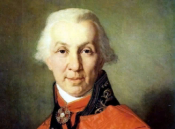
“Derzhavin’s Poetry is Russia itself ...”
July 14, 2020 marks the 277th anniversary of the birth of Gavriil Derzhavin, whose distinctive character allowed him to take place in two difficultly compatible areas at once: he managed to acquire the title of the first poet of Russia and selflessly worked in the public field - he served as governor of the Olonets and Tambov governorates, cabinet Secretary of Catherine II, Minister of Justice of Russia, and retired with the rank of senator and real privy councilor. The Presidential Library’s portal features the electronic collection Gavriil Derzhavin (1743-1816), consisting of the literary heritage of Gavriil Romanovich, his military and business notes, as well as digital copies of the memoirs of his contemporaries.
“On July 14, 1743, a poor officer who served in Kazan gave birth to a son named Gavriil”, - writes the author of historical novels, Count Evgeny Salias de Tournemire in his work The Viceroy Poet (1885). “The newborn was so weak and thin that, according to the then custom, he was baked in bread, that is, put in warm dough”. Life did not spoil the descendant of the ancient Tatar family. In 1762, Derzhavin, who did not graduate from high school, was suddenly requested to Petersburg, to the Preobrazhensky regiment. It turned out that due to the early death of his father, Gabriel was not in time, from childhood, enlisted in the noble military service and was now to serve in the soldiers.
“Having arrived in the regiment, he entered active service and lived with soldiers in the same barracks between many married and single”, - writes the poet, director of the Imperial Theaters Nikolai Ostolopov in the publication The Key to Derzhavin’s Works, with a Brief Description of the Life of this Famous Poet (1822).
Information about this almost ten-year period of service is contained in the work of the renowned philologist Jacob Groth The Activities and Correspondence of Derzhavin during the Pugachev Riot (1861) and Derzhavin’s Life according to his writings and letters and historical documents (1883). They detail the path that Derzhavin went from an ordinary to an officer. The author notes his unprecedented courage, manifested, in particular, during the Volga expedition aimed at pacifying the troops of Emelyan Pugachev.
Derzhavin proved himself in the governor’s field in the same decisive manner, which is reflected in The Notes of Gavriil Romanovich Derzhavin. 1743-1812.
The scale of the personality of Gavriil Derzhavin emerged during the period when he was the Minister of Justice of Russia. For example, Derzhavin’s detailed report on the case of Dmitry Lopukhin, one of the most notable corruption cases of the late 18th – early 19th centuries, is included in one of the volumes of the Senate Archive.
All this time Derzhavin matured as a great poet, taking stories from life itself - this is his path that Evgeny Salias de Tournemire traces in his study The Viceroy Poet (1885). In 1783 Derzhavin became widely known thanks to the ode “Felitsa” dedicated to Catherine II. The publication of the Imperial Academy of Sciences The Works by Derzhavin. Vol. 8. Biography of the poet (1880), the poet gives explanations for each line of the ode, based not on the emotions of a kneeling nobleman, but on the facts.
Derzhavin also ceated the ode “God”, the words of the unofficial anthem of Russia “Thunder of victory, give out!”, poems “The Nobleman”, “Rulers and Judges” and many other works. He followed the development of the literary process in Russia and was the first to evaluate the scale of the talent of a very young poet with an unknown surname Pushkin - this was on an exam in Russian literature at the Imperial Tsarskoye Selo Lyceum.
Close to the mark in the Historical Anthology dedicated to Derzhavin’s work, “his poetry is an indefinite, many-sided delight of a person who sees before himself the accomplishment of great things, glorious and beneficial events for the Fatherland... His odes are as brilliant as the century that he speaks of; they are also full of great paintings, as are the people who moved these events”.

